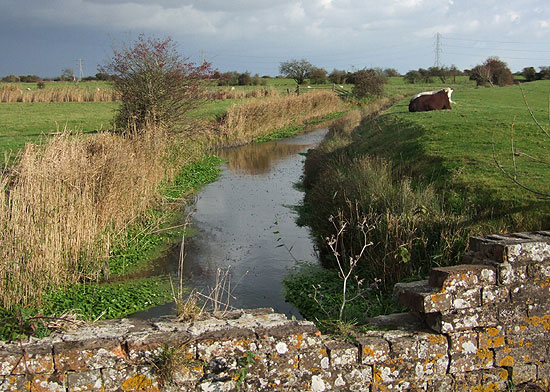Anti-Tank Ditches
Posted: 11 November 2007 22:43
I recently came across the following reference in an infantry brigade defence scheme:
Two anti-tank ditches, 10 feet wide and 6 feet deep, have been dug across the Pevensey Marshes from excluding Eastbourne to excluding Bexhill. Various crossings exist over these ditches. Some of these crossings have been prepared for demolition...the remainder will be obstructed with Anti-Tank mines on "Action Stations".
I found this rather intriguing, as I had no knowledge of these ditches. Fortunately, a map showed the location of them, and I was not surprised to find that they were, in fact, a network of natural water-filled dykes that criss-cross the Pevensey Levels.
I managed to trace the route of the ditches on the map below:

(Reproduced from the 1940 Ordnance Survey map with the kind permission of the Ordnance Survey)
What's interesting is that these ditches have made sense of several locations that I've previously visited. The roadblock at Rickney, some buoys at Norman's Bay and the mysterious crop of cubes in Cooden Moat are actually related.
The Rickney roadblock buoys and cubes were therefore sited as part of the anti-tank defences; one of the 'ditches' is crossed by the Rickney Bridge, and two road-cratering charges were also sited here.
The Norman's Bay buoys are not actually on a crossing point, but are on a sharp bend in the road alongside part of the ditch that runs to Eastbourne.
The cubes in Cooden Moat I now think were part of the ditch defence too, as the dyke runs all the way to Cooden and appears to terminate just by the Moat.
However, I was interested in why the scheme says the ditches had been dug when they were natural, so I jumped onto my bike this afternoon to take a look at a crossing near Rickney, to see if there were any roadblock remnants here too.
In the event, there were no signs of a roadblock on this narrow brick bridge, and as there were no crater charges scheduled here, it must have been a crossing to be blocked with anti-tank mines.

However, the ditch was of interest, as the lip of the right bank in the photo is higher than the left, perhaps indicating that the 'enemy' side of the ditches were artificially raised, hence being 'dug'.
As I'm still not up to full health, I didn't investigate any other parts of the ditches, but will take a closer look in the future and try to establish whether the bank has been bulldozed elsewhere to improve its anti-tank defence.
As the scheme that mentions the ditches is dated June 1941 and that of December 1940 makes no mention of even an intention to improve the ditches, it follows that work by the Royal Engineers or Pioneer Corps had not begun until at least January 1941.
However, I do now know why some defences were placed where they were, and this in itself is a satisfactory result so far on this.
- Pete

Email:
Blog Latest

Bishopstone reveals its pillbox secrets
18 October 2021

Pillbox or Observation Post?
10 June 2020

Uncovering the hidden secrets of a pillbox
8 June 2019

Review of 2018
31 December 2018

Wartime Christmas in East Sussex (2)
24 December 2018
Jargon-buster
Action Stations
A state of readiness issued whenever invasion was deemed imminent. This alert required 100% manning of defences.
Anti-tank ditch
Ditch designed to hinder movement of tanks and AFVs. Ditches could be entirely artificial or existing ditches or natural features such as rivers, might be dredged, shaped and revetted to improve their effectiveness.
Buoys
Small concrete roadblock obstacle comprising a truncated cone with domed base. A hollow shaft down the centre allowed the buoy to be manhandled using a crowbar. Buoys were deemed of little value by 1941 and cylinders seen as a better solution.
Cubes
Anti-tanks blocks, popularly known as dragon's teeth. Not to be confused with smaller blocks known as pimples, cubes can be upwards of 1m square. Many examples in Sussex have apexes or chamfered edges, leading to them being incorrectly recorded as coffins.
Defence scheme
A military plan of defence for a specified area. Defence Schemes were issued at numerous levels. Defence Schemes were later known as Plans to Defeat Invasion on the orders of General Montgomery.
Demolition
Term applied to a structure scheduled for demolition or already demolished. Walls and small buildings might be taken down to clear fields of fire or impede enemy passage by destroying a bridge. Some demolitions were not intended to be carried out until after invasion had begun, for example, certain bridges or road craters (pipe mines).
This site is copyright © Peter Hibbs 2006 - 2024. All rights reserved.
Hibbs, Peter Anti-Tank Ditches (2024) Available at: http://www.pillbox.org.uk/blog/216532/ Accessed: 25 April 2024
The information on this website is intended solely to describe the ongoing research activity of The Defence of East Sussex Project; it is not comprehensive or properly presented. It is therefore NOT suitable as a basis for producing derivative works or surveys!